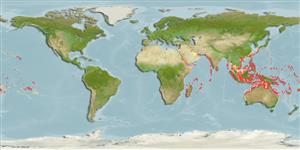Environment: milieu / climate zone / depth range / distribution range
Ekologi
marina; brackvatten revassocierade; djupintervall 2 - 80 m (Ref. 1602). Tropical; 34°N - 34°S, 27°E - 124°W
Indo-Pacific: Red Sea to East Africa eastward through northern Australia reaching Tuamotu Islands, north to southern Japan.
Size / Vikt / Age
Maturity: Lm ? range ? - ? cm
Max length : 60.0 cm TL hane/ej könsbestämd; (Ref. 9770)
Taggstrålar i ryggfenan (totalt): 3; Mjukstrålar i ryggfenan (totalt): 24-27; Taggstrålar i analfenan 0; Mjukstrålar i analfenan: 22 - 25. Scales relatively large (Ref. 9002).
Inhabits coastal to inner reefs and estuaries, often in silty habitats (Ref. 48637). Found on lagoon slope and floor (Ref. 30573), also coral reefs. Generally solitary or in pairs (Ref. 4420). Young form small aggregations when common while adults are usually seen solitary, except when nesting and males congregate on certain sand flats adjacent to reefs (Ref. 48637). Feeds on tips of coral branches, gastropods, crustaceans, foraminiferans, and tunicates (Ref. 1602) and also on sea urchins (Ref. 9770). Oviparous (Ref. 205). Nest-guarding females are aggressive (Ref. 9770). Also caught with drive-in nets. Marketed fresh and dried-salted (Ref. 9770). Ciguatoxic in certain areas (Ref. 37816). Maximum depth reported taken from Ref. 128797.
Life cycle and mating behavior
Könsmognad | Reproduktion | Lek | Ägg | Fecundity | Larver
Males migrate to a traditional spawning ground where they establish territories enclosing nest sites and egg chambers (Ref. 9777). Nesting occurs in sand-bottomed channels and shallow cuts through the barrier reef (Ref. 9778, 37816). The nest consist of depressions up to 2 m wide and 0.7 m deep (Ref. 9778, 37816). Females arrive several days later and select a male for mating (Ref. 9777). Exhibit biparental care (Ref. 9777). Up to 430,000 or more eggs may be deposited in a spongy fist-sized cluster weighted down with pieces of rubble (Ref. 9778, 37816). Males establish a territory for spawning and parental care but not for feeding (Ref. 116451). Only females tend the eggs but both parents keep guard (Ref. 116451).
Myers, R.F., 1991. Micronesian reef fishes. Second Ed. Coral Graphics, Barrigada, Guam. 298 p. (Ref. 1602)
IUCN Red List Status (Ref. 130435)
Warning: mysqli::__construct(): (08004/1040): Too many connections in /var/www/html/includes/func_getlabel.php on line 46
Can't connect to MySQL database (fbapp). Errorcode: Too many connections
